Dispatches from Oxford in the Realm of England
Henry M. Miller, HSMC Director of Research
This blog reports the experiences and findings of Dr. Henry Miller while he is on assignment at the Centre for Medieval and Renaissance Studies at Oxford, England. From September 2011 to May of 2012, he will be conducting research about early Maryland and its English connections, writing, and teaching. Watch this space for Dr. Miller’s research findings, insights on the remarkable history and nature of Oxford and other places he visits, and curious aspects of living in another country.
October 25, 2011
This past week, we finished the draft of a grant proposal for analysis of the Leonard Calvert House at St. Mary’s City and it is now out for initial review. Also, my wife, Carol, arrived for a few weeks visit. Currently, I am working on the histories of Trinity College here in Oxford, where George and Cecil Calvert along with John Lewger, the builder of St. John’s, were students. Each college in Oxford has its distinctive features and traditions and you cannot just examine the general history of the University to understand the experiences or attitudes of the students. There will be additional information on Trinity as I am able to delve more deeply into their archives.
One recent pleasure was meeting with an English gentleman named Barry Williamson.

Barry taught history in Bristol, England and has now retired. He spent his childhood at Swallowcliff in the County of Wiltshire, just a short distance from a place called Wardour Castle. Wardour was the home of the noble Arundell family since the 16th century. Growing up with Arundell family lore, history, and surviving buildings and playing on their manorial landscapes, Barry developed a lifelong interest in this important yet little-studied family. The last major publication on them was in 1916. To satisfy his own curiosity, Barry launched a study of the family, tracing their long history beginning in 1400s century Cornwall, their move to Wiltshire in the 1540s, and the remarkable family story since then. After years of research in archives, collecting memories from relatives and locals, and investigating the buildings and places associated with the family, Barry turned his quest into a book entitled The Arundells Of Wardour: From Cornwall to Colditz, just published earlier this year.

Reading it and in talking with Barry, the fascinating nature of this family is made clear. A Rescusant or Catholic family, they underwent many challenges to maintain the “ancient faith” and were one of the leading Catholic families in western England. They are most relevant to Maryland history because of the 1628 marriage of Anne Arundell to Cecil Calvert.
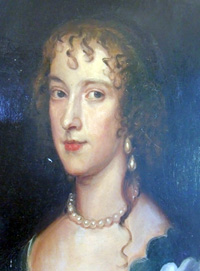
The picture here is the only surviving painting of Anne, a copy made from a 1630s original that is now missing. In a real sense, Anne was the mother of Maryland. After marrying Cecil, she supported him in his long campaign to establish a new English Colony in America. So did Anne’s father – Lord Thomas Arundell of Wardour. This image is a Van Dyke portrait of him as he looked about the time Maryland was founded.
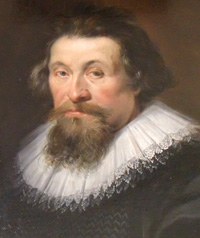
We do not know if Lord Arundell invested directly in the colony, but he did give more than just moral support. In the mid-1630s, when Cecil had spent absolutely everything he had to keep Maryland going, he was so poor that Lord Arundell had to provide them with food and other necessities, believing they would not be able to survive without his aid. While this is just a single sentence in one letter that Arundell wrote, it is very important because it tells us how truly risky the Maryland gamble was, and what a total and tremendous personal commitment the Calverts made to see their vision become reality.
It is also noteworthy that the Arundells were not strangers to the idea of English colonies in America. Thomas’s father, Matthew, had been an investor in the very first English attempt to create a settlement in the Newfoundland area in the 1574, an expedition led by Sir Humphrey Gilbert. Later in 1605, Lord Thomas Arundell of Wardour encouraged the establishment of a Catholic colony in America, although it never came off. He must have been a staunch supporter of his new son-in-law’s efforts for Maryland. And there is even one elusive hint in a surviving document that he might have been involved with George Calvert’s attempt to secure a grant south of the Chesapeake in 1630.
Anne’s father was a remarkable man. In the early 1590s, he sought permission to go off on a sea adventure to capture Spanish treasure ships. And in 1595, Queen Elizabeth sent him to Europe to provide assistance in the fight against invading Muslims. At a major battle in Hungary, Thomas was able to breach the defenses, capture the Muslim flag, and raise the standard of the Holy Roman emperor. This was a very big deal in military terms, and for it the emperor made him and all his posterity Counts of the Holy Roman Empire, a unique honor for an Englishman. And forever afterward, he was known as Thomas, the Valiant to honor his courage. The helmet of Lord Thomas Arundel still exists, mounted high on the church wall where he is buried in the village of Tisbury.
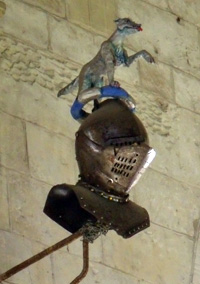
But Queen Elizabeth was not at all pleased with this award, stating that “Others should not place brands on my sheep”. Nor were many of the English nobility, for being a Count was a status equal or higher than theirs and human jealousy prevailed. As a result, Thomas was unable to publicly proclaim his new status. A few years later, in 1605, King James I made him a baron called Lord Arundell of Wardour, a belated recognition of his merits with an English title. This is a good place to point out that one should be careful when coming across a mention of Arundel in reading. Do not automatically assume it refers to Anne Arundell’s relatives. There were two prominent families with this name. The Wardour Arundells spelt their name with two “LL” s and lived in Wiltshire and Dorset. The Howards were the other family, with the titles Earls of Arundel in Sussex, and also Dukes of Norfolk. They have a single “L” in their spelling. It is this family that built the impressive Castle Howard in Yorkshire, and Thomas, Earl of Arundel, also became a major 17th-century collector of Roman art. His many outstanding acquisitions formed a major part of the original Ashmolean Museum collection here at Oxford and helped spur the study of classical art. I, too, become confused sometimes as to which of these two families are being referred to in original documents and even occasional publications, so wanted to try and clarify it.
During the 1630s, Thomas, Lord Arundell also built a fine stone house for Cecil and Anne Calvert in a place that affords a direct view of Wardour Castle, Anne’s original home. It is at this residence that Cecil oversaw the first years of Maryland, their son Charles (later the third Lord Baltimore) was born, and Philip Calvert, who had such a major role in later Maryland history, spent much of his childhood. Called Hook Farm Manor, this building still stands and is occupied by members of the current Arundell family. They have been extremely generous in permitting some limited tours to their home. This image shows the house with Calvert and Arundell descendents during a recent visit.
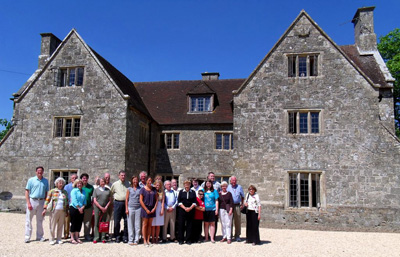
During the English Civil War, the Arundells were strong supporters of King Charles, and because of this, their home of Wardour Castle was besieged. In in 1643, during one of the more heroic episodes of that conflict, Lady Blanche Arundell, wife of another Thomas, the brother of Anne Arundel, led a valiant defense of their home , with only 25 soldiers and maids, holding off an army of nearly 2,000 parliamentary troops for eight days. She finally surrendered when they threatened to blow up the castle. But the Parliamentary forces did not honor the terms of surrender, plundering the house and its huge collection of art and other valuables. The following year, royalist troops returned and besieged the “Roundheads” holding the castle. Under unclear circumstances, gunpowder in a tunnel under the castle wall exploded and completely demolished one entire side of the stout structure, rendering it no longer habitable. You can see here the remains of Wardour Castle with the absent section from that 1644 explosion to the right.
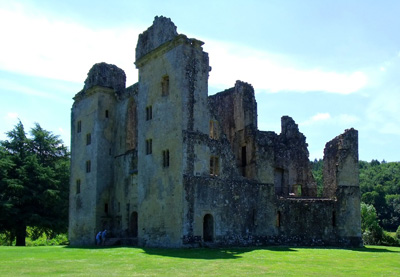
The family had mixed fortunes in later years but recovered to become one of the wealthiest families in Wiltshire. In 1776, they built a magnificent mansion named New Wardour that still stands. Within it is a Chapel of splendid beauty that remains today the center of Catholic worship in the area, a continuity that has endured since the Reformation.
The last of the direct line of the Lord Arundells of Wardour died in 1944, a consequence of being in a German prison camp, and with his death the title of Count also elapsed. Another branch of the family then inherited the property, one with ties to Ireland and still more links to the Calvert family. The amazing history of this family is masterfully summarized in Barry Williamson’s book and I recommend it to you highly. It is on sale at HSMC’s Shop at Farthing’s Ordinary.
Not only is there a county in Maryland named for a significant member of this family–Anne Arundel –(although lacking the second “L” for some inexplicable reason), there is also a section of what is now Annapolis called Wardour. Barry has generously shared some of his research data with me and we are pursuing some important unanswered questions about the Arundells, including their mysterious genealogical link to the powerful Robert Cecil, the man who gave a young George Calvert his chance, the person for whom the second Lord Baltimore was named and Cecil Calvert’s Godfather.


